Key issues
- In the week ending 13 February 2025, low-pressure systems brought rainfall to the north and east of Australia
- Excessive rainfall has led to widespread flooding across parts of North and Far North Queensland. Reports indicated that flooding continues to affect supply chains and is hampering damage assessment and cleanup efforts. Once flood waters begin to recede, growers will get a better understanding of the impacts on bananas and sugar cane, as well as other important horticultural crops.
- Rainfall totals of between 0-150 millimetres were recorded across eastern cropping regions, with the highest rainfalls in northern Queensland. These falls are likely to be sufficient to support average soil moisture levels and above average summer crop yield potentials.
- Over the coming eight days, Tropical Cyclone (TC) Zelia and low-pressure systems are expected to bring rainfall across much of the country, with exceptions in south and central regions.
- Across cropping regions, Queensland and New South Wales are expected to receive up to 50 millimetres of rainfall, this is likely to result in some harvest delays in early planted summer crops. Meanwhile, Western Australia is forecast to receive up to 25 millimetres. Little to no rainfall is expected in other cropping regions.
- The national rainfall outlook for March to May 2025 indicates an increased probability of above median rainfall across the north of the country.
- Higher than average rainfall is expected in northern areas of Queensland, Western Australia and the Northern Territory
- There is a 75% chance of rainfall totals being between 25 and 100 millimetres across most cropping regions. If realised, these forecast rainfall totals are likely to be sufficient to support autumn pasture growth across most of Australia. Additionally, these expected falls are likely to be sufficient to maintain above yield expectation for summer crops in Queensland and northern New South Wales and provide a boost to soil moisture profiles prior to the planting of winter crops during late autumn.
- Water storage levels in the Murray-Darling Basin (MDB) decreased between 6 February 2025 and 13 February 2025 by 269 gigalitres (GL). Current volume of water held in storage is 13,892 GL, equivalent to 62% of total storage capacity. This is 25 percent or 4,614GL less than at the same time last year. Water storage data is sourced from the Bureau of Meteorology.
- Allocation prices in the Victorian Murray below the Barmah Choke increased from $177 on 6 February to $190 on 13 February. Prices are lower in regions above the Barmah choke due to the binding of the Barmah choke trade constraint.
Climate
In the week ending 13 February, low-pressure systems and a monsoon trough brought very high rainfall to the north of the country. In the southeast, low-pressure systems contributed to showers and storms. High-pressure systems kept the remainder of the country largely dry.
- The northern tropics, including the Northern Territory and northern Western Australia recorded falls between 15-300 millimetres. Meanwhile, a monsoon trough brough falls of between 25-400 millimetres to much of northern Queensland, with higher falls in isolated areas.
- Reports indicated that flooding continues to affect supply chains and is hampering damage assessment and cleanup efforts. Once flood waters begin to recede, growers will get a better understanding of the impacts on bananas and sugar cane, as well as other important horticultural crops like sweet corn, tomatoes, beans, capsicums, mangoes, melons, and avocados.
- Southeast Queensland and eastern New South Wales received between 5–100 millimetres of rainfall, while eastern Victoria received up to 150 millimetres. Much of the remainder of country recorded little to no rainfall over the period.
Rainfall totals were generally low across cropping regions in the south:
- In the east, rainfall totals were highly variable. Northern Queensland received between 25-150 millimetres, with higher totals recorded in isolated areas. Southern Queensland and New South Wales received between 0-100 millimetres of rainfall.
- In contrast, southern cropping regions including Western Australia, South Australia, and Victoria received little to no rainfall.
Rainfall for the week ending 12 February 2025
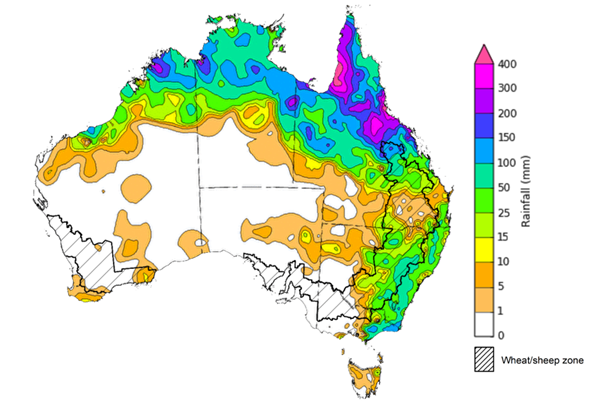
Issued: 12/2/2025
Note: The rainfall analyses and associated maps utilise data contained in the Bureau of Meteorology climate database, the Australian Data Archive for Meteorology (ADAM). The analyses are initially produced automatically from real-time data with limited quality control. They are intended to provide a general overview of rainfall across Australia as quickly as possible after the observations are received. For further information go to http://www.bom.gov.au/climate/rainfall/
Over the 8 days to 20 February 2025, Tropical Cyclone (TC) Zelia and low-pressure systems are expected to bring rainfall to much of Australia:
- Falls of between 50–150 millimetres are likely for much of northern Western Australia, the Northern Territory and northern Queensland.
- TC Zelia is expected to bring very high rainfall totals and potential flooding in effected parts of Western Australia, with up to 200 millimetres forecast for northern coastal regions.
- While the gale force winds and flooding associated with the forecast heavy rainfall may adversely impact some individuals and businesses, there will likely also be beneficial effects, such as providing a boost to soil moisture and pasture and crop production in other areas fortunate enough to avoid flooding.
- Between 10–50 millimetres are forecast for much of the east, include eastern Queensland, New South Wales and Victoria. In Tasmania, up to 100 millimetres of rainfall is forecast in the west.
- By contrast, a high-pressure system is expected to keep much of the remainder of the south and interior of Australia largely dry.
Rainfall forecasts across cropping regions over the coming week are mixed:
- Low rainfall totals are expected in southern cropping regions, including across much of South Australia and Victoria (between 1–10 millimetres). In Western Australia, higher rainfall totals of between 10-25 millimetres is expected.
- Higher rainfall is expected in eastern cropping regions, with Queensland and eastern New South Wales likely to receive between 10-50 millimetres. Rainfall forecast for summer cropping regions in Queensland and northern New South Wales is likely to be sufficient to support average soil moisture levels and above average summer crop yield potentials but may result in harvest delays in some early planted summer crops.
Total forecast rainfall for the period 13 February to 20 February 2025
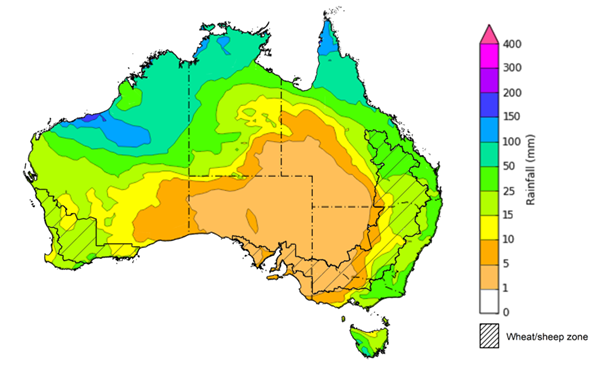
Issued 13/2/2025
Note: This rainfall forecast is produced from computer models. As the model outputs are not altered by weather forecasters, it is important to check local forecasts and warnings issued by the Bureau of Meteorology.
The El Niño Southern Oscillation (ENSO) and Indian Ocean Dipole (IOD) climate drivers are currently neutral and having minimal influence on Australian rainfall. The IOD is likely to remain neutral over the coming weeks, however, indicators suggest that chances of a La Nina event are strengthening. The Southern Annular Mode (SAM) is currently negative and may contribute to fewer rainfall events in eastern Australia.
The most recent rainfall outlook for March 2025 provided by the Bureau of Meteorology indicates that much of northern Australia, and parts of the west, are likely to see above median rainfall. For the remaining regions, rainfall is expected to be close to average for the period.
- The Bureau of Meteorology’s climate model predicts a 75% chance of March rainfall totals between 50-300 millimetres across much of the north, including northern Western Australia and the Northern Territory. Parts of northern Queensland are expected to see as much as 400 millimetres.
- Eastern Australia, including southeast Queensland, eastern New South Wales, eastern Victoria and Tasmania are likely to see between 10-100 millimetres of rainfall
- Lower rainfall totals are expected across western, central and southern areas, with much of southern Western Australia, southern Northern Territory, South Australia, and western Queensland, New South Wales and Victoria likely to see between 5–25 millimetres.
- Across cropping regions, there is a 75% chance of moderate rainfall totals of 10-25 millimetres across summer cropping regions in Queensland and northern New South Wales. If realised, this rainfall is likely to support above average yield prospects for summer crops and average or better levels of pasture production in affected areas.
Rainfall totals that have a 75% chance of occurring in March 2025
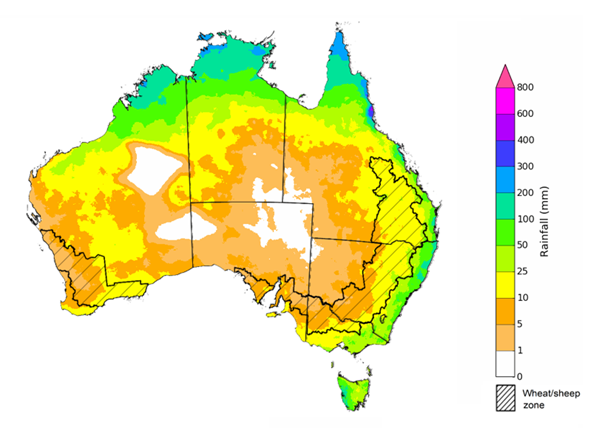
Issued: 13/2/2025
The rainfall outlook for March to May 2025 indicates an increased probability of above average rainfall across large areas of eastern, northern and western Australia. Much of the south of the country is equally likely to receive above or below median rainfall.
Across cropping regions, the chance of receiving above median rainfall is between 55–70% across much of Queensland, with New South Wales and Western Australia having a 55–65% chance of above median rainfall. In South Australia and Victoria, the chances of receiving above or below median rainfall are approximately equal.
Chance of exceeding the median rainfall March 2025 to May 2025
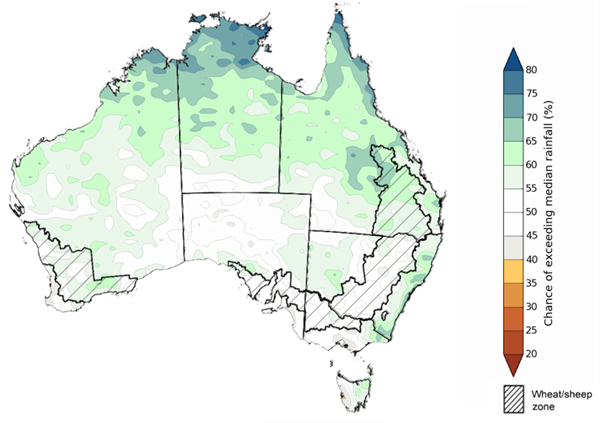
Issued: 13/2/2025
The rainfall outlook for March through to May 2025 suggests a 75% chance of receiving rainfall totals of between 50–600 millimetres across northern Western Australia, the Northern Territory, and Queensland, with rainfall greater than 600 millimetres expected in far-north Queensland. Between 25–200 millimetres of rainfall is forecast across much of southern Queensland, New South Wales, Victoria and Tasmania, with rainfall totals exceeding 200 millimetres likely across coastal and alpine areas. Southern Western Australia and South Australia are likely to receive rainfall totals of between 25–200 millimetres over this period. In central Australia, little to no rainfall is forecast over the period.
In cropping regions, there is a 75% chance of receiving between 25-100 millimetres. If realised, these forecast rainfall totals are likely to be sufficient to support autumn pasture growth across most of Australia. Additionally, these expected falls are likely to be sufficient to maintain above yield expectation for summer crops in Queensland and northern New South Wales and provide a boost to soil moisture profiles prior to the planting of winter crops during late autumn.
Rainfall totals that have a 75% chance of occurring March 2025 to May 2025
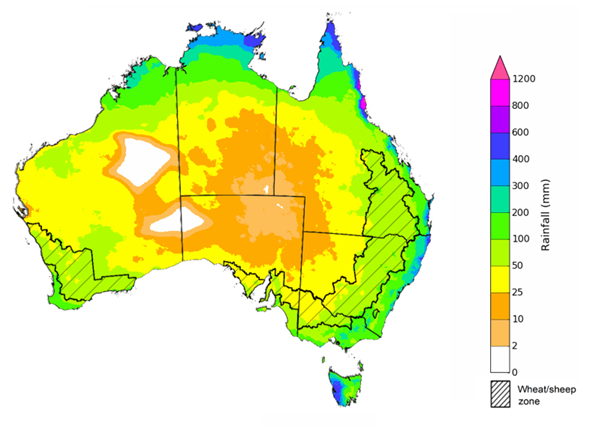
Issued: 9/1/2025
Water
Water storages, water markets and water allocations - current week
The Tableau dashboard may not meet accessibility requirements. For information about the contents of these dashboards contact ABARES.
Commodities
Information on weekly price changes in agricultural commodities is now available at the Weekly commodity price update.
